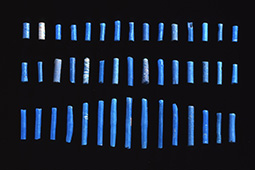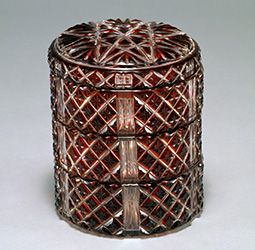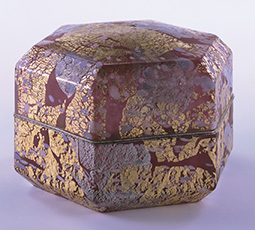November 2022
- English
- 日本語
Glass Use and Glass Crafts in Japan

Tsuchida Ruriko, director of the Toyama Glass Art Museum 
Panels from Subtle Intimacy by Sasaki Rui, (each 84 cm × 44 cm × 1.4 cm), Grand Prize winner at the Toyama International Glass Exhibition 2021

Tubular pieces of blue glass called kudatama excavated at the Yoshinogari Ruins in Saga Prefecture 
Satsuma Kiriko Sandanju (three-tiered box made from Satsuma Kiriko cut glass) (Collection of the Kyushu National Museum) (19th century) (Height 12.4 cm, Diameter 10.3 cm) 
Ornamented Box “DAIGO” by Fujita Kyohei (Collection of the Toyama Glass Art Museum) (2003) (19 cm × 30 cm × 26 cm)

This year, 2022, is the “International Year of Glass” as designated by the United Nations General Assembly. We spoke with Tsuchida Ruriko, who is the director of the Toyama Glass Art Museum and a member of the International Year of Glass Committee of Japan, about the history of glass use and glass crafts in Japan.

Humans are believed to have been making glass for more than 5,000 years. Please tell us about the history and characteristics of glass.
Glass that largely consists of silica sand, which is mainly composed of quartz, soda ash* and lime, is thought to be the first artificial material made by humans. Initially, it was used ornamentally as a substitute for natural stones such as turquoise and crystal. Later, it was also utilized in accessories such as jewelry, bottles, bowls, and so forth used by nobles. From the 19th century, when glass manufacturing technology advanced rapidly and mass production became possible, glass spread among ordinary people through everyday items such as windows and lamps. In recent years, glass has spread even to places where it is difficult to notice. For example, glass fibers have come to be used in automotive and aircraft components (see here).
One of the important properties of glass is its transparency. Since it lets light through and refracts it, glass is used in glasses, telescopes, and microscopes. And even though people perceive glass to be fragile, by changing the ingredients and manufacturing method, it can also become a highly durable material. For example, special heat-resistant glass was used at the tip of the space shuttle fuselage, which becomes extremely hot due to friction with air. Another characteristic of glass is that it can be processed into various shapes. Therefore, it is possible to make various industrial products and crafts according to application and design.
Can you give us an overview of the International Year of Glass?
In May 2021, the United Nations General Assembly decided to designate 2022 as the International Year of Glass. As I mentioned, glass has played a key role in the advancement of science, technology, and culture. It will remain an important material for humanity in the future. For example, glass is a recyclable material, so it will play a major role in achieving the Sustainable Development Goals (SDGs). However, this importance of glass is not recognized well by the general public.
With this in mind, the International Year of Glass promotes a vision to “celebrate the past, present, and future of this transformative material.” In order to make more people aware of the role and potential of glass, all kinds of educational programs, exhibitions, and science and art events related to glass are held around the world.
In Japan, there are also exhibitions of glass crafts, events to experience glass making, and initiatives to distribute teaching materials to schools that introduce the diverse uses of glass. On December 8 and 9, the closing ceremony of the International Year of Glass will be held at the University of Tokyo. Experts in glass-related science, technology, and art from all over the world will gather and give lectures. For my part, I plan to talk about the founding of the Toyama Glass Art Museum where I’m the director, and other initiatives promoted by Toyama City as a “City of Glass.”**
When did the use and making of glass begin in Japan?
It is believed that glass began to be used in Japan about 2,000 years ago. Some of the oldest items of glassware in Japan are the 79 tubular pieces called kudatama excavated at the Yoshinogari Ruins in Saga Prefecture, a large-scale archaeological site dating back to the 1st century. These beautiful items of blue glassware were found as grave goods in a tomb where a noble appears to have been buried. It is speculated that the individual kudatama were joined together with a string and worn like a crown on the head. As is common around the world, glass was first used for personal accessories. People believed that wearing glass would dispel evil spirits and bring them more power.

However, it is speculated that glass products at this time were brought from mainland China or that raw materials from mainland China were processed in Japan. It is believed that the collection of raw materials and the processing of glassware within Japan began in the latter half of the 7th century. From the Asukaike Ruins in Nara Prefecture, which is an archaeological site from that time, various glass beads in green, yellow-green, blue, and other colors, raw materials such as quartz and lead, and relics such as molds for processing glass into beads have been discovered. These glass beads were used as decorations for Buddha statues and temple halls, and as chindangu***.
However, when the Heian period (late 8th century to late 12th century) came to an end and samurai families came to power in place of the aristocracy, glass was rarely used in Japan, although it is not clear why. It is just my guess, but samurai may have thought that fragile glass is inauspicious.
When did glass start to be used again in Japan?
In the middle of the 16th century, when exchanges with countries such as Portugal and Spain began, various European products were brought to Japan. Among the tribute brought to powerful daimyo (feudal lords) were items of glassware not seen in Japan at the time. This encounter with glassware, which unlike ceramics and lacquerware is transparent and highly artistic, increased the momentum for glass production in Japan. Glass products in Japan then underwent considerable evolution during the Edo period, which lasted for about 260 years from the beginning of the 17th century. It is thought that glass blowing started in Nagasaki in the early to mid-17th century and kiriko, Japanese cut glass modeled after cut glass from the United Kingdom and other parts of Europe, was born in the early 19th century. In the middle of the 19th century, a variety of Satsuma Kiriko in crimson, indigo and purple (see here) began to be manufactured.

A major feature of kiriko from the Edo period is its brilliance and feel. Lead was one of the raw materials for Japanese glass. Glass containing lead has a high transparency and refractive index of light. When light hits the kiriko, the surface of the glass shines in seven colors like a prism, which is truly beautiful. Since I used to be a curator, I have often directly touched European and Japanese cut glass for museum exhibitions. European cut glass has a heavy feel, and in some cases surface unevenness may bite into your hand, which actually hurts a bit. On the other hand, the touch of Japanese kiriko is gentle and even feels warm. You can feel that the craftsmen have carefully and gently polished it.
How did glass develop after the Meiji period (1868–1912), when Japan modernized?
In the Meiji period, as Japan modernized, the demand for glass products such as sheet glass and daily necessities such as lamps and bottles increased, so the Meiji government made it a national policy to develop the glass industry. In particular, sheet glass was indispensable for Western-style architecture, so they focused on manufacturing it. The government set up glass factories and invited engineers from Europe. Among the Japanese employed there were many former kiriko craftsmen. In 1902, the first Japanese sheet glass was successfully made. After that, the glass industry developed greatly, supporting the modernization of Japan.
From the 20th century, people began to use glass as a means of artistic expression. Initially, many were designers and craftsmen working for glass manufacturing companies, but after the middle of the 20th century, independent artists also emerged. One of the pioneers was Fujita Kyohei (1921–2004). After studying metalwork at Tokyo Fine Arts School (presently the Tokyo University of the Arts), Fujita began working at a glass factory, yet quit after about two years. Later, in 1964, he released Rainbow Colors, one of his masterpieces, in which hot molten glass expresses a flowing shape. In 1973, he released another of his masterpieces, Ornamented Box and Fujita continued to make many Ornamented Box works throughout his life. His boxes, made with generous use of gold leaf, were popular not only in Japan but also overseas. When Fujita was asked overseas about the purpose of Ornamented Box, he replied, “Put your dreams inside,” which is why it is known as “Fujita’s Dream Box” overseas. In 2002, Fujita became the first glass artist to be presented with the Japanese Government’s Order of Culture.

What kinds of artworks have been made with glass in recent years?
In the past, glass sculptures were the mainstream, but since 2000, works that combine glass with various media such as video, sound, and photography are being created in Japan and overseas. For example, the Toyama Glass Art Museum hosts the Toyama International Glass Exhibition, an international public exhibition held once every three years since 2018, which is an opportunity to learn about this diversity. The 2021 exhibition received 1,126 entries from 51 countries and regions around the world. Among them, the work that won the Grand Prize was Subtle Intimacy by Sasaki Rui. Sasaki created the work by sandwiching plants collected from places she visited across the whole of Japan between two pieces of sheet glass and firing them in a kiln. The kiln-fired plants and ashes between the sheets of glass appear white under LED light and their details are unveiled as if they were herbarium specimens. Taking advantage of the characteristics of transparent glass, this is an unprecedented work that preserves memories of each place via the plants.
Various Japanese artists have created works that express the charm of glass in their own way, attracting international attention. I’d like to continue to spread awareness, both in Japan and abroad, about the directions that glass artwork is taking within contemporary art.
* Anhydrous sodium carbonate. In addition to glass, it is used as a raw material for soap and dyes.
** https://www.iyog2022.org/home/closing_ceremony_japan/
*** Chindangu are goods buried for deities of the land before building temples.

